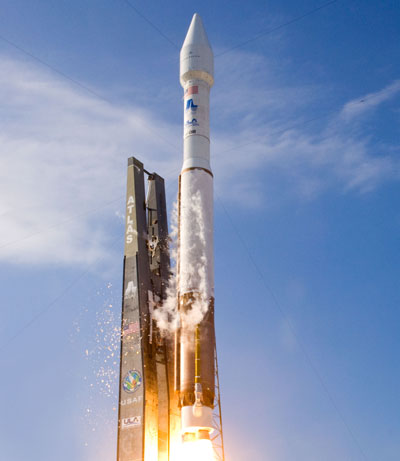Can we sustain a commercial launch industry to meet NASA’s needs?by Edward Ellegood
|
| Relying on one or two companies for this strategically important capability could prove disastrous, especially given the fact that no company has yet demonstrated that they are up to the challenge. |
We could look to the Evolved Expendable Launch Vehicle (EELV) program for an example. Like Griffin’s view of human spaceflight, the Air Force considers access to space for satellites to be a strategic capability that must be maintained by the government. However, the Air Force decided long ago not to design and operate their own launch vehicles. They recognized that big aerospace/defense contractors had sufficient expertise to do the job, and they gambled that these contractors would remain healthy and provide competitive pricing by tapping into the commercial satellite launch market.
As it turned out, the launch companies were indeed able to meet the Air Force’s launch requirements, but have been unable (some would say unwilling) to leverage the commercial satellite business. Given the prices the government was willing to pay for Delta 4 and Atlas 5 launches, and the (some would say onerous) schedule and operating requirements laid out by the Air Force, the companies have had little incentive to chase additional commercial business. The result has been steady increases in EELV costs and an almost complete lack of commercial launches at the Cape Canaveral Spaceport.
So would NASA be in the same boat if they contracted out for commercial crew flights to the International Space Station? Perhaps. Industry groups like the Commercial Spaceflight Federation say NASA’s decision to purchase commercial crew flights would jump-start multiple new markets in Low Earth Orbit, and the Augustine committee seems to agree. According to commercial launch advocates, the situation is not unlike the startup of commercial aviation after the government decided to contract for air mail service. No one doubts that commercial companies will soon be technically capable of supporting human spaceflight, the question is whether NASA would ultimately be saddled with the responsibility for maintaining (some would say subsidizing) this third-party capability, much like the Air Force now does for the EELV rockets.
| We also should not overlook the benefits that could come from changing (some would say fixing) the way the government procures and manages its launch capability. |
Of course, this is all based on the assumption that NASA’s Ares 1 rocket will be canceled, which may not happen. But even if it does, NASA may not have to rely exclusively on these commercial providers. The agency’s next-generation heavy-lift vehicles, whether Shuttle-derived or EELV-based—though intended primarily for cargo—could also be designed to carry astronauts. As with health care, this “public option” could help to keep down commercial prices.
We also should not overlook the benefits that could come from changing (some would say fixing) the way the government procures and manages its launch capability. Many factors that drive up costs for today’s launch programs could be mitigated through procurement changes that would increase competition, improved approaches for managing our nation’s launch ranges and spaceports, and smart changes to other existing federal policies and laws.
